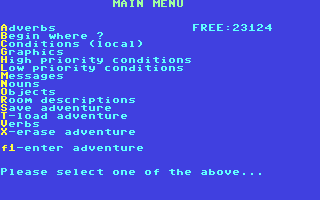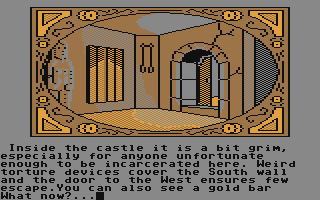|
GAC
is a sophisticated adventure writing package on a single
cassette or disk. It has advanced graphics, and allows
multiple commands in a single input, full word recognition
and a host of other features intended to make this the
state of the art adventure writing utility. Its appearance
on the Commodore should allow rapid conversions of a
host of adventures written for other micros, breaking
down the barrier of compatibility that previously existed.
The
packaging is very neat. GAC comes in a large
format cassette/disk holder complete with a glossy covered
manual. The printing isn't remarkable, but the manual
explains every detail of the utility with care and precision,
sometimes with accompanying graphics where it is thought
they may help. Loading is achieved easily thanks to
use of fast loading techniques and the user is presented
with a title/credit screen followed by a menu page.
GAC itself leaves approximately 23K free for
your adventure. Larger adventures could be created with
multiple loading techniques, but at some time in the
future Incentive would like to release GAC II which
would have the advantage of disk accessing capabilities.
This means that the adventure can be as big as the author
desires.

[This screenshot was not in the original
review]
To
give you an idea of just what this package is capable
of, Incentive include a couple of mini adventures. One
is a pure text offering; the other uses graphics. If
the full solution to the adventure is known, the entire
game may be played in one input. The result is like
a short story, punctuated with a series of commands.
It's an impressive demonstration of GAC's power.
As
with any utility of this type, the more complex the
graphics, the less memory is available for the rest
of the adventure. However, while this might suggest
the need for simplistic graphics, Incentive have made
sure that the author has the opportunity to make up
complex images, should they be required. Also included
are a host of memory saving devices to make the process
painless as possible.
The
graphic screen allows four pure colours to be used,
though these may be stippled in any combination to give
the effect of up to ten colours and textures on screen.
The top two thirds of the screen is surrounded by a
frame in which an image may be created. To the left
of the frame there is a bar containing sixteen colours.
From here, the colours being used may be checked and
altered. To the right of the frame is the pen and paper
symbol. The pen is always shown in the selected colour
for drawing and rests on the paper during the drawing
process itself.
Below
the frame is a menu for the various operations to be
carried out in the picture. ELIPSES, BOXES, FILL, MULTI-DIRECTIONAL
MIRRORING, SLOW and FAST DRAWING, PICTURE MERGING, and
PICTURE or STAGE deletion are all included along with
a picture scan that allows analysis and alteration of
any stage in the creation.

[This screenshot was not in the original
review]
The
mirroring and merging sections are very important from
a memory saving angle. If you draw say, half a picture,
and use the mirror to complete it, only three bytes
are used on the second half. Likewise, if a picture
is drawn and then has a frame decoration added (previously
drawn as a separate picture), only three bytes are used.
This cuts down tremendously on possible repetitiveness.
Most
of the features work smoothly, but the exception to
this neatness is the FILL command. This isn't perfect
and an optimum position within the area to be filled
needs to be found. Even then, in an awkward shape a
gap may be left. This can be rectified by implementing
FILL a second time from a better position, and the final
result will be no different from that achieved with
a more capable routine. However it does take up more
memory, and this is arguably offset by the fact that
this FILL command takes up very little memory itself
and is particularly fast.
The
ability to LOOK and DELETE back either a single step
or a whole picture makes correction and modification
to pictures very easy indeed. The effect of open or
closed doors is just one example of how these features
cater for the kind of conditions often required of adventure
graphics. Because it is possible to change the ink during
the course of a picture creation, and then change it
back again when the whole picture is asked for, a limited
form of animation is possible. Things such as flashing
lights or other relatively small changes to detail to
a picture can be attained with the minimum of effort.
Up
to 255 separate pictures are possible with GAC.
Because of the way pictures are tied to locations, it's
possible to have small pictures created as inserts,
displaying recently acquired objects, for instance.
The potential for experimentation is enormous.

In
the rest of GAC, like most other adventure writers,
up to 255 words may be defined as part of the vocabulary.
As full word recognition is catered for in GAC,
shortened versions of words (such as EXAM for EXAMINE)
have to be created as synonyms by giving them the same
numerical value in the vocabulary table. This does,
however, create the opportunity for more diversity and
flexibility.
One
aspect of GAC which is slightly unusual is that
unlike The Quill, words are stored alphabetically
rather than numerically. This means the vocabulary has
continuity, but synonyms are harder to locate when editing.
There
can be 255 of each noun, verb and adverb. The section
ADVERBS actually includes prepositions, so the label
is an arbitrary one. However, this does allow for detailed
analysis of each player input and consequently greater
flexibility in terms of acceptable player response.
The
interpreter is the real gem in GAC. If you have
ever wanted to create Infocom style adventures but have
been held back by the limitations of The Quill
or lack of programming ability, then this is where GAC
can solve your problems. Commands are not limited either
to verb/noun input or single command per sentence input.
Instead, a whole series of commands may be entered so
long as the author has taken full advantage of this
very sophisticated parser. Multiple commands may be
punctuated by AND, THEN, '.' or ',' in any fashion the
author requires.

'IT'
recognition is also possible if IT is made object number
255. This way IT always refer to the last noun mentioned.
This allows commands as 'GET THE LAMP THEN LIGHT IT'
to be used. If an error is made partway through the
command (such as trying to the an object that isn't
there), the rest of the command is ignored.
Another
area where GAC excels is with the conditions.
GAC uses HIGH, LOW and LOCAL priority conditions
to set up certain events under particular circumstances.
GAC checks a HIGH condition before the player
has the opportunity to make an input. Such things include
checking whether a lamp is switched in to allow looking
at things in the dark.
LOCAL
conditions are those pertaining to a particular room
or situation only. If you exited an airlock without
a space suit for example, GAC would check this
and kill you before you could do anything else. LOW
priority conditions are checked in the same way as local
ones except that they are not confined to individual
rooms. They might check that you were carrying an object
regardless of where you are, simply to ensure a message
continued to appear.
Setting
conditions always involves altering the numerical status
of flags which indicate the necessity of certain actions
or responses from the computer. GAC has two types
of these, called COUNTERS and MARKERS. COUNTERS are
variable between 0 and 255 and there are 128 of them.
MARKERS simply switch between 0 and 1 but there are
256 of these. They differ only in the way they are applied
to a game to get the most efficient possible use from
them.

Following
the now predictable GAC format, 255 messages
are allowed. Clever use of these messages (ie, breaking
them down into commonly used sections) saves memory
and increased the apparent number of messages in the
adventure. This technique is not exclusive to GAC
but it is reassuring to see that such things are
possible nevertheless.
Editing
any part of GAC is simplicity itself. Everything
is well explained in the manual -- all the different
parts if GAC may be accessed from a main menu
and the whole effort has been logically devised. If
you are saving files to cassette, GAC automatically
puts a fast loader on them. Disk and cassette files
are totally interchangeable, making it possible to upgrade
your adventures with the minimum of fuss.
GAC
sells at a price that can hardly be called cheap. However,
all things are relative. When you compare this to the
competition, both in terms of price and performance,
it comes out way on top. Future, more powerful versions
are planned, but this should not put you off getting
hold of a copy as soon as possible -- any future versions
will be a while off yet. It has already set a new standard
on the other micros, and a Commodore version was needed
to make the whole exercise worthwhile. Incentive have
learned from the odd shortcomings of these earlier versions
and this has been to the benefit of Commodore owners.
They have made a superlative product even better.
|